Hoi An Ancient Town is a top favorite city of antiquity in Vietnam, which is known for its ancient and colorful beauty. The city has received high rankings by the international tourism magazines that appreciate the old houses, beautiful lanterns, delicious food, tailor-made clothes, and laid-back lifestyle. Regardless of the busy lifestyle and noisy beeps, things in Hoi An remain classic and idyllic, making it an ideal retreat to calm every soul and beautify their travel stories. Nowadays, to serve the tourists, some local old houses have been turned into classic coffee shops, homestay sites, and eateries. Not only does the old town win praises for the cultural tours, but it’s also attractive for the food tours associated with the hands-on cooking classes. Visitors who like to cook can try making the chicken rice or banana blossom salad, following the local recipe. If you’re interested in 16th-17th century architecture, Hoi An is a living museum for a perfect walk. In 2019, Hoi An was ranked the best city in the world by Travel & Leisure, and other award-winning titles. There is much more great information about the introduction to Hoi An Ancient Town, so read on and find out if it can inspire an actual visit.
Overview of Hoi An Ancient Town
Hoi An city was recognized as a UNESCO World Heritage Site in 1999. The city preserves the exceptional example of the Southeast Asian trading port dated back to the 15th – 19th century. The buildings and street plan of the city reflected a combination of the indigenous and foreign impacts. History buffs would love to explore each antique corner of the town, and the outstanding names are Japanese Covered Bridge (Chua Cau), Tan Ky Old House, and Phuc Kien Assembly Hall. The architecture of the age-old attractions offers the look and feel of the old-time when the city served as a dynamic trading port. Note that there are other ancient houses scattered throughout the town. Other attractions include Tra Que Vegetable Village, Kim Bong Carpentry Village, My Son Sanctuary, An Bang Beach, and Cua Dai Beach. Top things to do in Hoi An Ancient Town cover the check-in at the historical bridge and the ancient houses in which the structure remains original with Kim Bong carpenter’s chambers, Bat Trang layering brick, and sophisticated carvings. Buying good silks from Bao Khanh Silk, B’lan Silk, or A Dong Silk is an interesting rewarding activity. And if you like a bike trip, let’s ride to Tra Que Vegetable Village, which takes around 15 minutes from the town. Tra Que Bike Tour fulfills your day with organic vegetables and local herbs. The local Hoi An food is also a great magnet attracting foodies, families, small groups, and couples. People love sharing happy culinary experiences, and some are eager to try hands-on cooking. A visit to the local market will cheer everybody up as you’re likely to find many dishes under USD 1.
Geographical Location
Hoi An Ancient Town is located in Quang Nam Province, central Vietnam, on the north bank next to the mouth of the Thu Bon River. The city is around 25km southeast of Da Nang City and 50km northeast of Tam Ky City. It has a total area of 61,71 square kilometers. Hoi An is about 9km east of 1A Highway. The east of the city borders a beach of 7km long. The center of the Hoi An City consists of the Minh An, Son Phong, and Cam Pho districts, of which the old town of approximately 5km2 was the property inscribed by the UNESCO (December 04, 1999). As of 2008, the administrative structure of the city includes 9 districts: Minh An, Son Phong, Cam Pho, Tan An, Thanh Ha, Cam Chau, Cam An, Cua Dai, Cam Nam (consisting of 55 towns), and 4 villages: Cam Thanh, Cam Kim, Cam Ha, and Tan Hiep (including 23 hamlets in total).
Around 18km from the mainland is the Cu Lao Cham Archipelago with an area of 15,49 km2 (covering 25,1% of the total area of the city). The archipelago covers numerous islands of various sizes, such as Hon Lao, Hon Dai, Hon Ong, Hon Tai, Hon La, Hon Nom, etc. The islands make up the arc overlooking the East Sea and protecting the mainland. Cu Lao Cham – Hoi An was designated as the UNESCO Biosphere Reserve on May 26, 2009. Besides the advantageous locations next to the Chu Lai Airport (Quang Nam Province) and Da Nang International Airport, Hoi An has another special edge because it’s set on the “heritage road of Central Vietnam” including Hoi An – My Son – Hue. This is the positive condition that makes it an attractive tourist destination. Together with the history and culture tours in the Old Town, Hoi An Town is also ideal for island tours toward An Bang Beach and Cua Dai Beach, which was ranked one of the 50 most beautiful beaches in the world. The 7m coast is also spotlighted with numerous 5-star beachside resorts and hotels, which are awesome.
Weather Characteristics
The destination features two major seasons: the rainy and the dry, with an average temperature of 29 Celsius degree.
- The most scorching period is between June and August when the temperature might reach its highest of 38 Celsius degrees in the daytime.
- The coldest months are often from November to January, with an average temperature of 20 Celsius degree.
- The rainy season might stretch from September to January, featuring heavy rain and the storm, which cause flood and damage tourism. There is a possibility of storm and strong wind which prevents the boat trip to the Cu Lao Cham Archipelago.
- The dry season lasts from February to May, when it is mild with less humidity and moderate temperature.
- People can expect calm weather between May/June and the end of August when the sea becomes calm, and the wind changes its direction. The island visit is mostly ideal during this period, making it a high season for domestic tourism.
Introduction to Hoi An ‘s History and Development
Hoi An History
Cham Period (Century II – XIV)
The early history of Hoi An Vietnam was about the people of Champa and the Champa Empire when Hoi An functioned as the commercial capital. The river system was used to transport goods between the highlands, inland areas (of Laos and Thailand), and the lowlands. Under the reign of the Champa Empire, Hoi An was named “Lam Ap Pho,” an important trading port, frequently visited by the trading boats from China, Arab, and Persia. The major imported items were silk, pearl, gold, aloe wood, and tortoiseshell. Old documents recorded that “Lam Ap Pho” played a critical role in the establishment and growth of the Tra Kieu Capital as well as My Son Sanctuary.
Dai Viet Period (Century XV – XVIII)
- In 1306, Cham and Vietnamese signed a land treaty. The Cham King gave Dai Viet two provinces of O and Ly for an exchange of the long-term peace and the marriage with Huyen Tran Princess.
- In 1471, Emperor Le Thanh Tong added Champa and Hoi An to form a Vietnamese urban or capital of Quang Nam Province.
- In 1570, the Nguyen Lords made Hoi An an important trading port. The English sailors and early Portuguese Jesuits had their residences at Hoi An.
- The town was divided by the Japanese settlement across the Japanese Covered Bridge (of the 16th-17th century).
- In the 18th century, Hoi An grew to be the best trading port in all of Southeast Asia and even Asia, considered by the Chinese and Japanese merchants. Besides, it was a powerful and exclusive trade channel for the ceramic industry. There were proofs proving that the Asian ceramics were exchanged from Hoi An to even Egypt.
The Recession Period (Century XIX – Early XX)
- After the prominent growth, in 1775, Hoi An became the battleground between Tay Son rebels and the Trinh army, which destroyed the city. Then, with Emperor Gia Long’s victory, to repay the French for their support, he gave them exclusive trade rights in the nearby Da Nang port town, which made Da Nang a new trading center. Meanwhile, Hoi An was forgotten.
- Over the next 200 years, Hoi An remained nearly untouched, partly due to the disadvantageous natural conditions like unstable tides and storms.
The Revive and Growth Period (Century XX – XXI)
- After the year 1975, when the country was liberated, the city and its residents went through different times to overcome the harsh war consequences, starvation, and unemployment. Thanks to the strong will of self-reliance and solidarity spirit, the people of Hoi An gradually found a way to recover the economy and the culture.
- In the 1990s, there were attempts to revive the city by international visitors. They are a Polish architect, a conservator, and an influential cultural educator. As a result, Hoi An was brought back to the world. There was even a statue of the Polish architect in the town, which also functioned as a symbol for the relationship between Poland and Vietnam.
- Nowadays, Hoi An Ancient City is famous for history, culture, and food tours. Numerous hotels, restaurants, and bars have been built in this tourist destination and its surrounding areas. The boats are kept for fishing and serving tourists. Tourism becomes one of the major income sources of the city.
Traditional Values and Awards
- On 19 March 1985, Hoi An Ancient Town was recognized as Vietnam’s National Cultural Heritage Site.
- On 04 December 1999, Hoi An Ancient Town was inscribed as a UNESCO World Heritage Site for its exceptional and universal values, which required protection for the benefit of all humanity.
- On 12 August 2009, Hoi An Ancient Town was ranked as Vietnam’s Special National Cultural Heritage Site.
- In 2019, Hoi An was ranked the best city in the world by Travel & Leisure.
- In 2020, TripAdvisor voted Hoi An in the Top 25 most famous destinations in the world, as of Travelers’ Choice Awards.
- In 2021, Hoi An surpassed Singapore in the list of Top 15 Best Cities in Asia by Travel & Leisure. Hoi An was the only city in Vietnam included in the Top list.
The authenticity of the town remains as it has retained the traditional wooden architecture and townscape. The buildings are backed onto the rivers, the canals, quays, and bridges of the original settings are preserved. The historical landscape and street plan of the city were intact. As the old town is open for tourism, revenue from entrance tickets is invested in the management, preservation, and promotion of the heritage site. There are even master plans, action plans, and research to ensure the intact status of the property and protect it from any external threats.
Introduction to Hoi An Ancient Town’s Means of Transport
About the transport from Da Nang City, driving a car from Da Nang to Hoi An Ancient Town will take around 30 minutes. The easiest way for a group to get to Hoi An is to “rent a car and driver.” Otherwise, if you prefer the more economical way, think of the bus services. However, if you’re going in a group, a taxi is still the best and most convenient way. A bus is a public means of transport, so it involves several downsides. If you’re a solo traveler or being on a budget, take a bus instead.
About Hoi An Taxi, the local taxi is cheap, and the drivers are honest, in general. There are two main taxi companies, which are Mai Linh (green) and Faifoo (yellow); both use meters. Oftentimes, the taxis hang out in the corners of Le Loi Street and Tran Hung Dao Street. You can call them or hail a taxi in the street.
About Grab’s taxi and motorbike taxi, they provide the cheaper alternative ways to get around Hoi An Old Town. The Vietnamese equivalent to Grab is FastGo, which is often cheaper than the standard taxis. However, if you’re considering traveling to Da Nang from Hoi An by Grab, be cautious that Grab is more expensive than hiring a private car & driver.
About motorbike Taxi or “Xe Om,” make sure you agree on the price before you get on. Or it’d be better to write the number and show the driver, so there could be no misunderstanding. Without a doubt, this is a cheap way to roam around the Old Town and its nearby attractions. For instance, a trip from Hoi An Old Town to Cua Dai Beach would cost around VND 40,000. Whenever you feel the driver is driving too fast or too careless, make sure to express your opinion. You’re just advised to use the “Xe Om” during the daytime; nevertheless, be more careful at night.
About renting a bicycle to bike around the town, it’s a perfect channel. The town is small and flat, so it’s feasible to move from one site to another by bicycle. Another version is to hire an electric bike which saves you from using your muscle. The journey on this two-wheel vehicle is interesting. That’s why you’re likely to meet many foreigners riding a bicycle towards the nearby beaches and around the Town’s old house attractions.
About traveling by water, a boat trip in Hoi An Ancient Town is worth experiencing. You can book a boat ride towards Kim Bong Carpentry Village or just explore the Thu Bon River in the evening. The lanterns on the river make it more beautiful than ever. Note that the charge is measured by boat, not by a person, which could cost around VND 150,000 – 200,000 to hire a boat in 1 hour.
About Hoi An Shuttle Bus or Electric Cars, they appear in white-and-green which is available for being used as a taxi. You can phone and inform them of how many people are in your group, and then they will quote the price and pick you up. The tickets are also sold at 487 Hai Ba Trung and 127 Phan Chu Trinh. The one-way ticket price is VND 10,000/person.
About a cyclo, this means of transport is best to experience in the early evening when the sun cools down and the town is illuminated by sparkling lanterns. A typical cyclo trip around the Old Town will take around 15 – 20 minutes for a cost of VND 150,000 – 200,000. You can try to bargain, and when you agree on the price, make sure to write it down, show the cyclo driver, and confirm again. This ensures no mistake. Take notes of the cyclo’s number plates, which are managed by the local police.
Introduction to Hoi An Ancient Town Entrance Fee
Guests need to buy an entrance ticket to enter Hoi An Ancient Town and visit its attractions. The ticket price is VND 12O,000/person (roughly USD 6). The ticket would include 5 pieces, which means you can visit 5 places. When you want to get in an attraction, show a piece of your ticket, and then the ticket checker will cut off that piece. Make sure you keep the entrance ticket during your stay in the Hoi An walking street because the ticket pieces are required to be able to enter an attraction. If you lost it, then you need to buy the ticket again. There scatters a total of 11 Ticket Stalls around the outskirts of the Old Town walking street that you can easily spot a stall to buy the ticket. Note that when you pay the entrance fee, you will receive the ticket and a map of the Hoi An Ancient City including the interesting places. As you have a map, this means you already bought the ticket and you will be allowed to get in the Old Town, but obviously, to enter an attraction, you need to show your pieces of the ticket. Therefore, keep your valid Hoi An Ancient Town Entrance Ticket and do not lose it.
Introduction to Hoi An’s Top Tourist Attractions
Japanese Covered Bridge
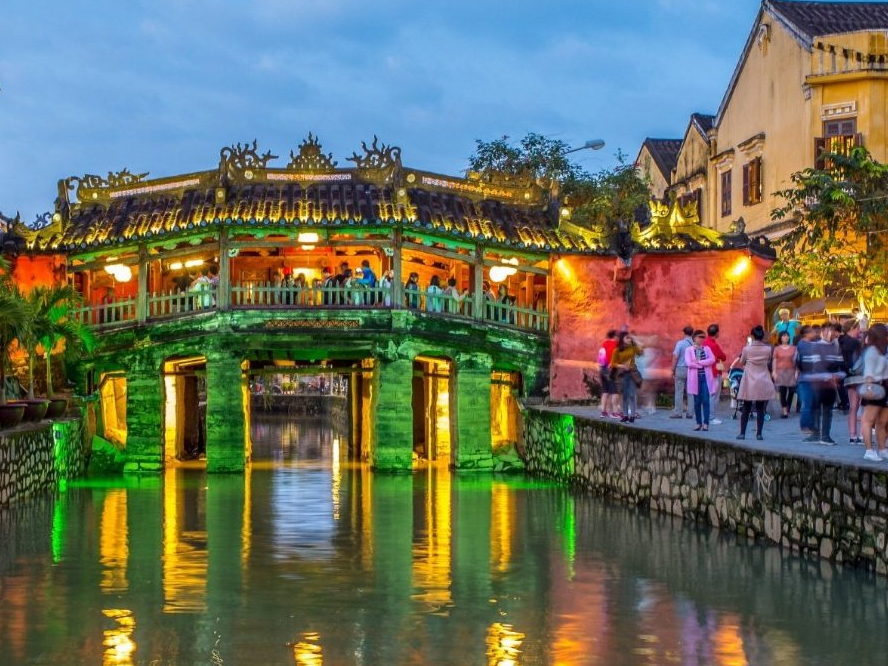
“Chua Cau” or Japanese Covered Bridge was built in the 16th century, by Japanese merchants. The Bridge connected Tran Phu Street and Nguyen Thi Minh Khai Street. It is a unique covered structure with a shrine attached to one side of the bridge. The antiquity of the site makes it a property attached to Hoi An image. Constructed above the Hoai River, the Bridge is quite curving with a length of 18m and its layered roof facing the Thu Bon River. The shrine was to worship “Bac De Tran Vu” Saint who helped control the storm and the flood to protect the locals and also bring prosperity to them. Going through the ups and downs of history, the Japanese Covered Bridge has been a symbol of Hoi An Tourism, and every tourist is recommended to visit it. It is ancient in each detail, and the actual touch will tell you how. A trip to Hoi An could not be complete without a picture that you’re standing in front of this antique property.
Tan Ky Old House
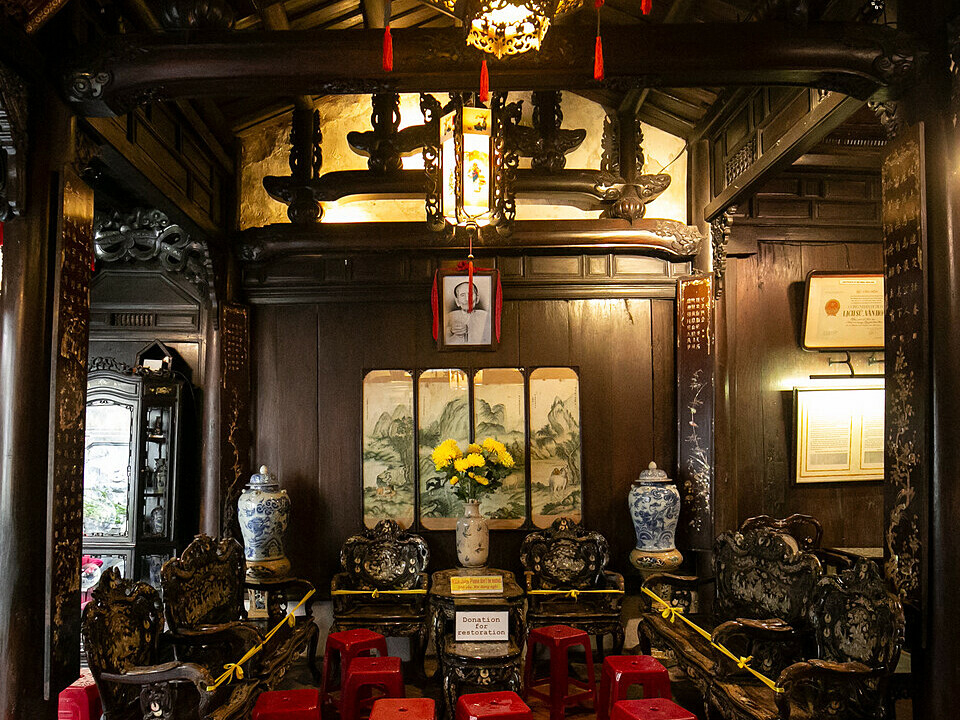
Among the top old houses in Hoi An Ancient Town, Tan Ky Old House is the most popular name. It was listed as a National Historical Vestige in 1985. It was built by the local merchant family who was wealthy and fastidious during the 18th century. They focused on the mastery of China – Japan – Vietnamese architecture and furniture, which were kept original in the house. The 18th-century details were incorporated in the carvings under the eaves, the chambers, the columns, and furniture objects. Opening for tourism, this Old House preserves the histories of the local family, how they constructed it, and why they made it here and there. The knowledgeable tour guides might tell stories for a glimpse of history. There is also a small vendor booth of souvenirs for sale. The great thing is that photography inside the house is permitted, and visitors can take some good shots when they sit on the antique chairs or drink tea on the age-old tables. The overseas tourists do love this kind of back-in-time journey so you’re likely to meet other buddies that share love in history.
Phuc Kien Assembly Hall
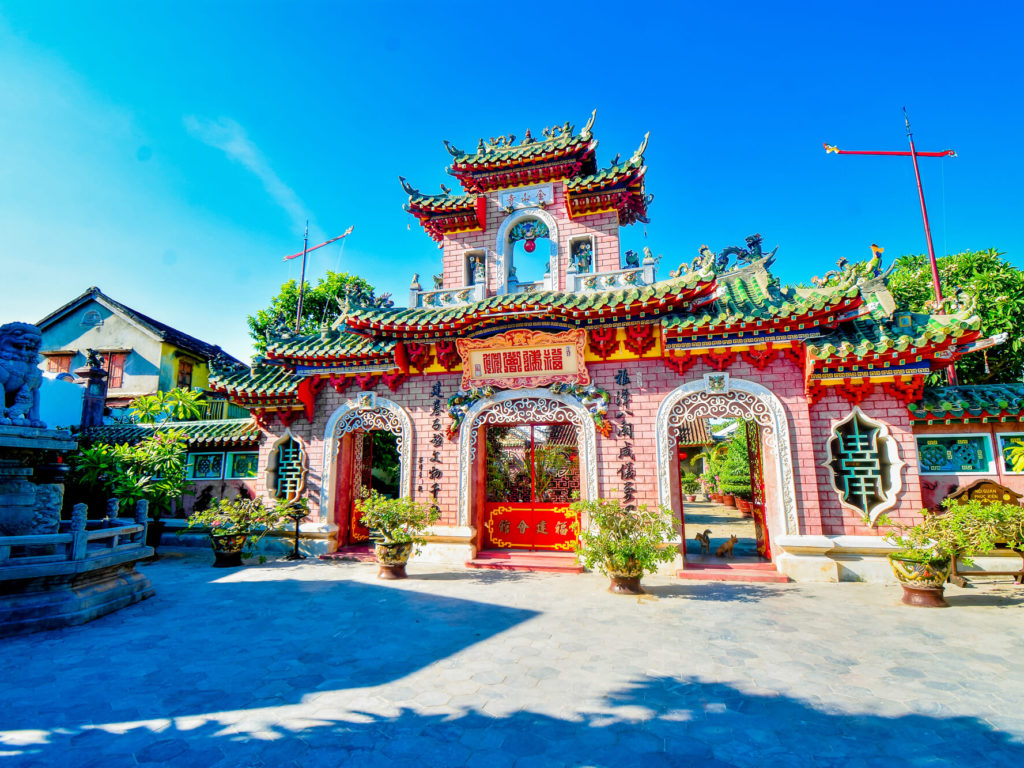
Phuc Kien Assembly Hall was a multi-functional community hall of the Chinese, which was erected in 1697. Then, in February 1990, it was made a National Historical Vestige for the antique architecture and exceptional values. Not only did the Hall serve as a temple, a conference room, a worshipping venue, but it’s also a shrine. Many years ago, the Hall was used as a shrine to worship Thien Hanh Thanh Mau Goddess that safeguarded fishermen from the sea. The Hall preserved the historical architecture in each detail. Also, it’s the spiritual value of it that leaves a huge impact on the locals’ religion and belief. Up to now, the architectural details of the Hall remain original, so it attracts the history fanciers to listen to its stories, touch, and feel the long-lasting values.
Phung Hung Old House
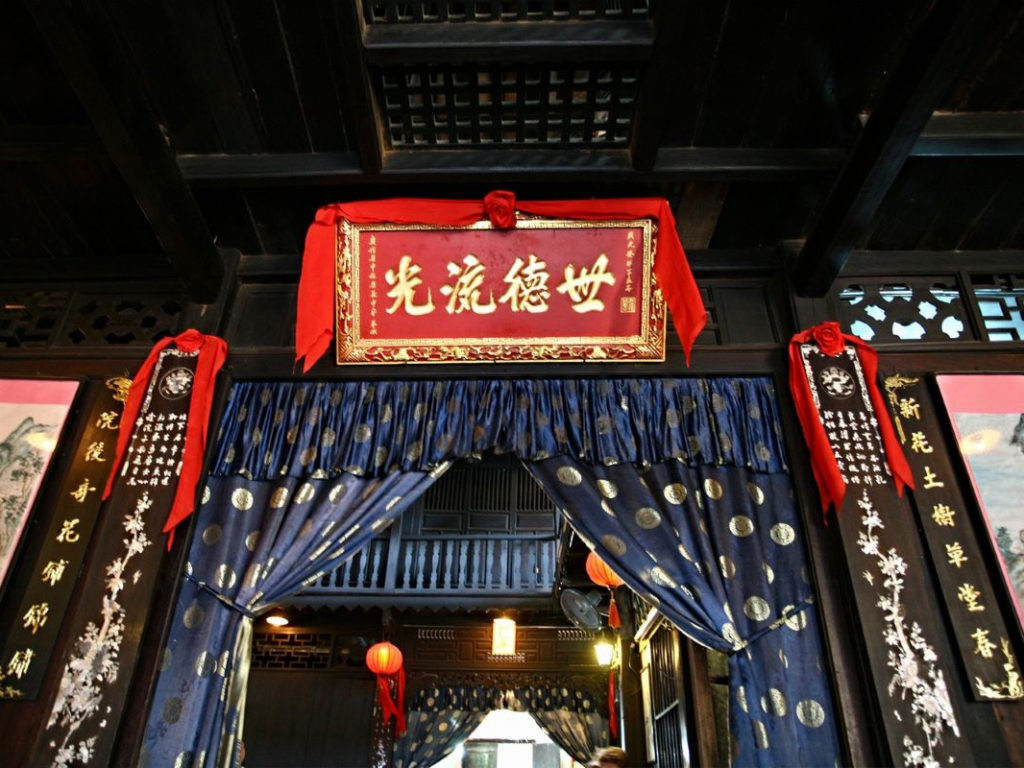
Phung Hung Old House was constructed in 1780. This is where you find the carvings of the Kim Bong carpenters, plus the special architecture of the high wooden balcony. Such architecture reflected the cross-cultural blends of Japan, China, and Vietnam in the past. History says that this place was originally used for exchanging goods of silk, glass, pepper, and salt. The house also stored lots of papers about the life and work of the merchants who lived in the old Hoi An trading port. In 1993, Phung Hung Old House was recognized as a National Historical and Cultural Vestige. Make sure you include it in the must-sees!
Hoi An Museums

The history of the region is exhibited in the four museums which are managed by the Hoi An Center for Cultural Heritage Management and Preservation. Hoi An Entrance Ticket already covers the entrance to the museums. You can read a glimpse of the museums below:
- The Museum of History and Culture is situated at 13 Nguyen Hue Street. It was originally a pagoda, erected in the 17th century by Minh Huong villagers for worshipping the Guanyin. The museum stores the ancient relics from the Sa Huynh, Champa, Dai Viet, and Dai Nam periods.
- The Hoi An Folklore Museum is located at 33 Nguyen Thai Hoc Street. The site is the biggest two-story wooden building in the city. The second floor exhibits 490 artifacts, organized into four sectors including plastic folk arts, performing folk arts, traditional occupations, and artifacts of the local life.
- The Museum of Trade Ceramics is nestled at 80 Tran Phu Street. It was built in 1995, in a restored wooden building. This is where you find the proof about Hoi An as an important trading port in Southeast Asia. It stores ceramic items from Persia, India, China, Thailand, and other regions.
- The Museum of Sa Huynh Culture is set at 149 Tran Phu Street and was established in 1994. This museum is about the Sa Huynh’s artifacts which proved the existence of the original settlers of over 2000 years ago.
Tra Que Vegetable Village

Tra Que Vegetable Village in Hoi An is among the loveliest villages in Vietnam. It is located between the Old Town and An Bang Beach, which is about 3km from the town center. The escape to the village is fresh, peaceful, and photogenic. It attracts visitors to the authentic photography of nature and the verdant organic veggie gallery. The best channels to access the site are bicycles and motorbike, but oftentimes, people enjoy a 15-minute biking trip. The 40-ha farming area is a venue of green organic vegetables, which use no chemicals in planting. As the major vegetable provider to Hoi An, Tra Que Village only supplies the freshest and cleanest veggies. People appreciate the local veggies for their best quality and health benefits. It has a natural aromatic smell thanks to the seaweed manure. Oftentimes, it takes 20 days from the day of first raising seeds to the harvest day. The villagers use a kind of algae from a local lagoon instead of the medical fertilizers. This results in green, natural, and tasty veggies.
The verdant site is awesome for Nature Photography. Other matchless highlights include the ideal lighting for photographing Hoi An sunset, the countryside farming scenes, more than 40 kinds of herbs and vegetables, etc. Check out the Tra Que Bike Tour Half Day if you enjoy a bike tour. Then, dress and work as a local farmer. The accompanying tour guide will be there to support. Last but not least, this village is famous for the herbal foot massage using the local herbs, which is relaxing enough to revive every soul. The Tra Que entrance ticket is VND 35,000/person.
Cua Dai Beach
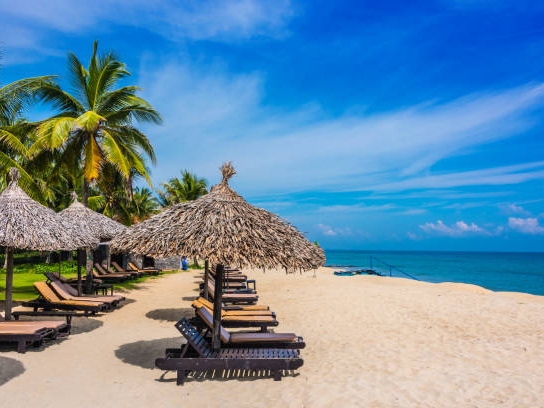
Cua Dai Beach is the best beach in Hoi An Ancient Town, surely. Also, it was ranked one of the 50 most beautiful beaches in the world. Just a few kilometers from the town, this beach is perfect for a bicycle tour where people will enjoy a ride on the two-wheel vehicle across the scenic scenery toward the stunning beach site. It is where you shower yourself with the vitamin sea, the smooth sandbank, the transparent water. If you embrace any ideas for the beach photo arts, Cua Dai is a place to undertake it. Take pleasure in sunbathing, relaxing, and putting every feeling of unease behind the back. Or you can just let the wind and the wave take it away.
An Bang Beach
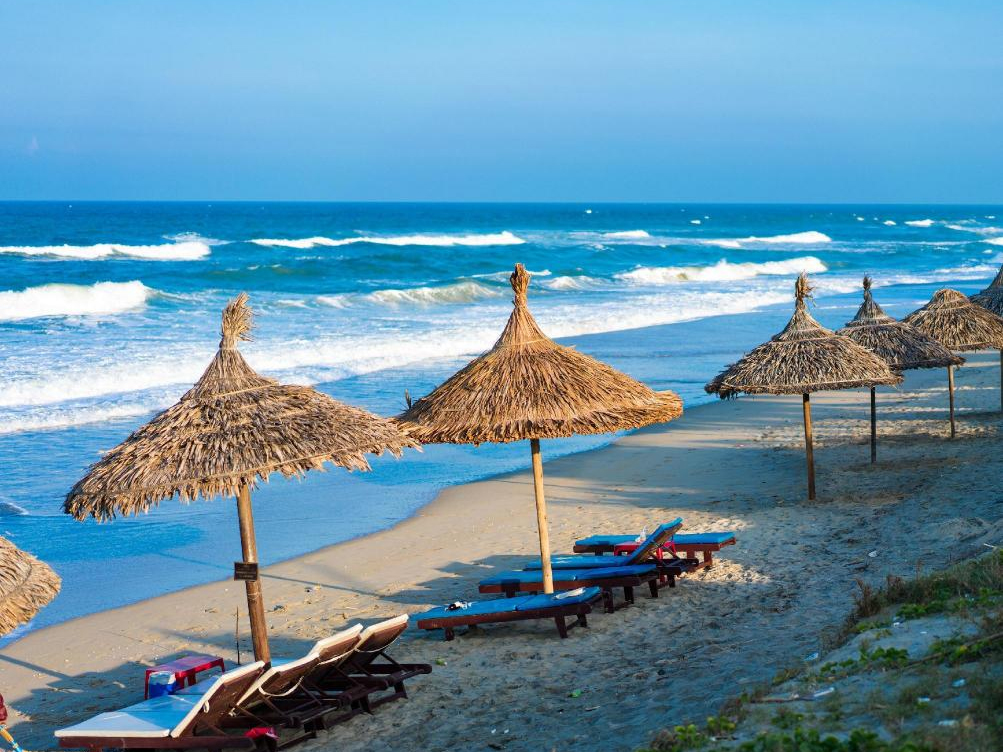
Around 7km from Hoi An Old Town, the unspoiled and spectacular An Bang beach attracts vacationers coming to swim, surf, and relax to the fullest. This beach site shelters a series of beachfront constructions, ranging from resorts to hippy bars, and seafood restaurants. It keeps entertaining people thanks to both natural beauty and manmade entertainment sites. So, if you ask about the top romantic things to do in Hoi An, then it’s recommended to visit An Bang Beach at once. On this beautiful beach, couples can unwind amid the sea breeze, cool beers, cocktails, and fresh seafood. Also, the experiences are awesome when you both can enjoy a bicycle tour from the Old Town to the beach. Of course, the cycling routes are very scenic for sightseeing and photography. Or if you’re not ready to bike, take the 5-minute taxi ride for your convenience. Make sure to check in on this beach.
Kim Bong Carpentry Village

This village is set on the right bank of the Thu Bon River. It was founded in the 15th century when the first Vietnamese forefathers exploited the Northern Delta region. The best channel to access Kim Bong Carpentry Village is a boat trip on the Thu Bon River from the Old Town. Upon arrival, you can expect to meet generations of carpenters who have greatly contributed to the age-old sophisticated architecture of the old houses in the city. In particular, the architecture of Tan Ky Old House was the artwork of the skillful carpenters of Kim Bong Village. History says that the carpentry business in this handicraft village most developed during the 18th century when Hoi An was the busy trading port of Southeast Asia. Such business could be categorized into three: (1) houses in the urban, (2) wooden furniture and gadgets, (3) shipbuilding. By visiting Kim Bong Village, travelers can find good wooden souvenirs from statues to handicrafts and family tools. The wooden artworks in a workshop can tell how skillful the artisans are. So, enjoy a scenic boat trip on the Thu Bon River and buy some wooden souvenirs. Note that there is no entrance fee to visit this handicraft village.
My Son Sanctuary

Nestled in Duy Phu Commune of Duy Xuyen District, My Son Sanctuary is a consecrated Hindu temple of the old Champa kingdom. The sanctuary is about 40km from Hoi An and 70km from Da Nang City. It was dedicated to worshipping Linga and the Shiva divinity. The place preserved more than 70 brick constructions dated from the 7th to the 13th century. Its characteristics were built from sandstone and burnt brick and decorated by the elaborate carvings as well as bas-reliefs on the thin mortar walls. Going through the ups and downs of history, the sanctuary survived though it was abandoned for periods, and then later, it was discovered by a French scientist, M.C Paris in 1898. My Son Sanctuary was announced as a UNESCO World Heritage in 1999.The ancient look and feel of this long-lasting Hindu-themed temple are hard to find elsewhere. So, if you appreciate the Champa architecture and the “museum objects,” get there to witness the well-preserved Hindu towers. There is even the Hoi An Day Tour to My Son Sanctuary that guests can experience a one-hour drive to access the old remnants, which are set in the mystic 2km-diameter area bordered by forests and mountains. It’s an interesting journey to role-play as an archaeologist who is learning Hindu architecture, the Champa civilization, and mythology.
My Son Sanctuary’s entrance fee is VND 150,000/adult and VND 30,000/child (from 6 to 11 years old). Its opening hours are from 6 AM to 5 PM every day.
Hoi An Market
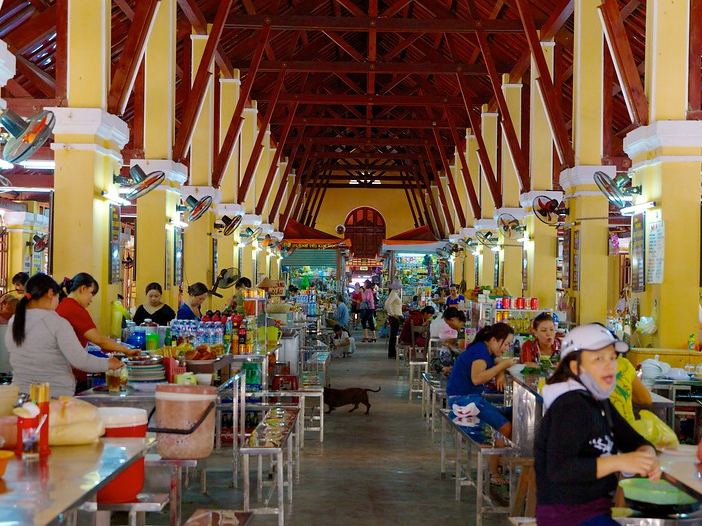
It can be said that Hoi An Market is somehow on a par with other traditional markets like Borough (London, England) and Tsukiji (Tokyo, Japan), which is filled with great food, tradition, and authentic culinary experiences. Highly ranked by Lonely Planet, Hoi An Market is the top food paradise consisting of many food stalls that serve the local delicacies, street dishes, souvenirs, clothes, lanterns, and more. The market is set on the riverside of the Hoai River, which offers a fresh and cool landscape. This culinary venue is where you buy the signature items of Hoi An, from the printed T-shirts to the handmade souvenirs. And of course, the food on the spot is yummy. You find it super-easy to eat food under USD 1. After treating your belly nicely, don’t forget to take photos of the yellow wall that is a symbolic background for a Hoi An Market tour.
Hoi An Ancient Town is a must-seen destination in most of Vietnam sightseeing tours
From South to North Vietnam Tour 12 Days
From North to South Vietnam Tour 15 Days
Introduction to Hoi An’s Most Beautiful and Most Impressive Resorts
Victoria Hoi An Beach Resort & Spa
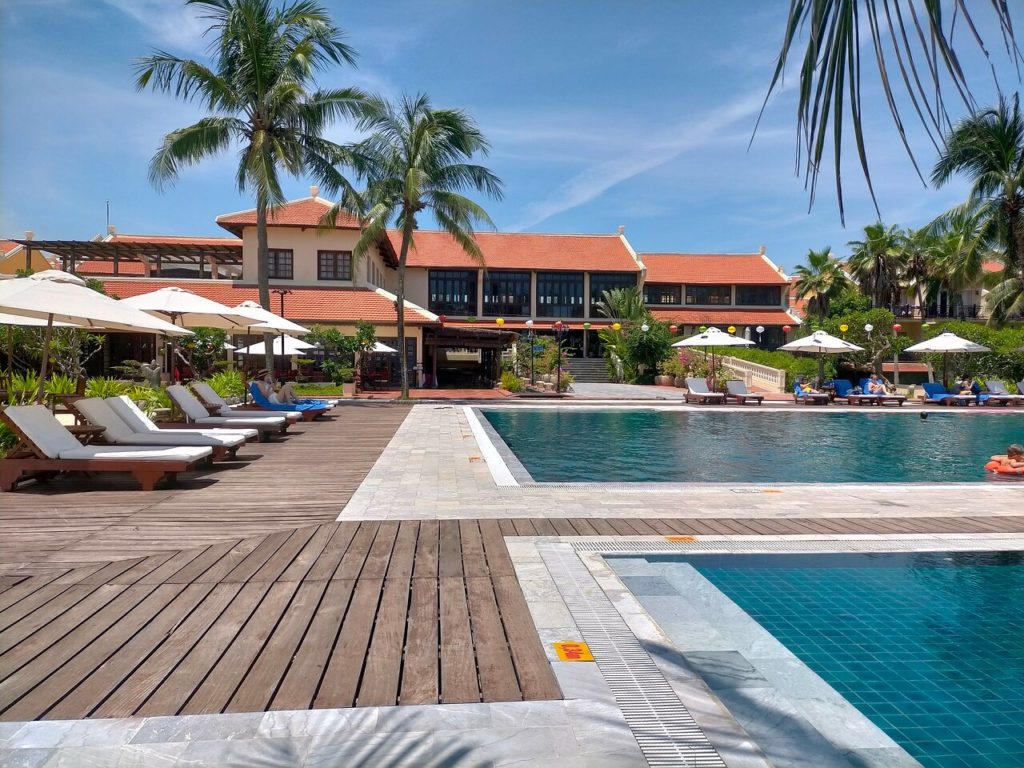
Location: Cua Dai Beach, Hoi An, Quang Nam
Located in a beautiful setting nearby the spectacular beach and under the blue sky, Victoria Hoi An Beach Resort & Spa is among the top choices of accommodation in Hoi An Old Town. The architecture of the site blends and filters from the combination of Japan-France-Vietnam. Entering the entrance to the resort, you will get into the classical old-looking atmosphere, which is also filled with a sense of luxury. It only takes 15 minutes to walk from the resort to the amazing Cua Dai Beach. The facilities and amenities in the resort are far from your expectation. There is a total of 109 rooms, designed in luxurious architecture, well-equipped with sufficient comfort, and customer-focused service. This hotel is indeed the very best choice for relaxation during your stay in Hoi An.
The Palm Garden Beach Resort Hoi An
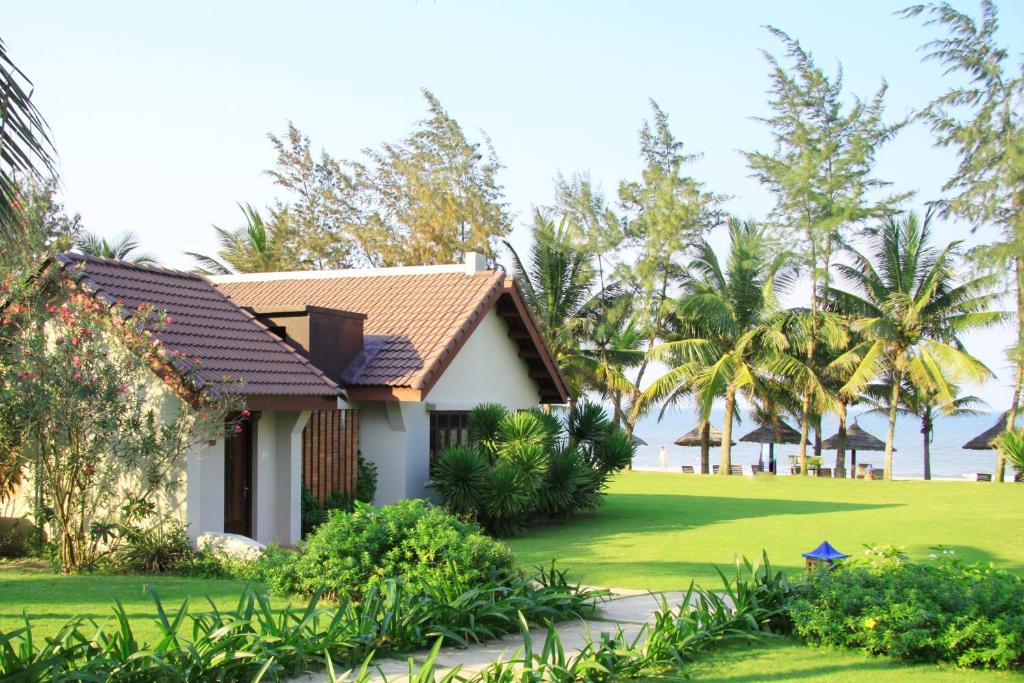
Location: Lac Long Quan Street, Hoi An, Quang Nam
This is one of the best resorts in Hoi An that is nearby the beach. It merely takes 3 minutes to walk to the famous Cua Dai Beach. Not only about the ideal beachside location, but this resort also offers a convenient transfer service to the Hoi An Old Town for the 5-minute ride or even toward Da Nang International Airport in 30 minutes. Built on the 5-ha tropical garden, the green beauty of the areas surrounding the resort showers it with the utmost freshness. The wide ranges of palm trees look so fresh and green that urge visitors to refresh. The Palm Garden Beach Hoi An has 212 rooms, divided into three types (Superior, Deluxe, and Bungalow Beach Front). The furniture is made from wood, which looks classical. If you stay in the beachfront bungalow, the experience would be ultimately impeccable.
Sunrise Premium Resort & Spa Hoi An

Location: Au Co Street, Cua Dai Beach, Hoi An, Quang Nam
Also, among the gorgeous resorts along Cua Dai Beach, Sunrise Premium Resort Hoi An has 222 rooms and villas overlooking the sea. This is an incredibly beautiful destination for family and small groups of friends, thanks to the luxurious, high-end designs for every room and villa. Plus, the professional hospitality service guarantees your experiences of 5 stars. Whenever you want to relax, check out the outdoor swimming pool, the spa, the restaurant, and especially the nearby beach. The entire view of the resort from the top is just awesome. It is a haven in which many artistic photos of luxury have been generated.
Golden Sand Resort & Spa Hoi An

Location: Au Co Street, Cua Dai Beach, Hoi An, Quang Nam
Also lied on the Au Co Street is the elegant Golden Sand Resort & Spa Hoi An, which is the ideal retreat for families and small groups. The name of the resort has talked much about its characteristics that are for comfort, luxury, and relaxation. With 212 elegantly-designed rooms, the site focuses on nature-friendly and aesthetic values; therefore, the major materials are wood and granite for the warm and eco atmosphere. On the campus, you’ll be pleased to walk under the palm trees, on the golden sandbank, or lie on the hammocks between the coconut ranges. Especially, the outdoor swimming pool of Golden Sand Resort & Spa is the largest one in central Vietnam, with a length of 150m. Don’t miss the spa services!
Vinpearl Hoi An Resort & Villas

Location: Block 06, Phuoc Hai, Cua Dai, Hoi An, Quang Nam
As one of the best 5-star resorts in Hoi An, Vinpearl Hoi An Resort & Villas becomes a target for the wealthy vacationers who want to invest in the finest and travel to the fullest. The destination owns the perfect rooms and ritzy villas to nurture your body and mind. It offers the villas that many individuals are longing to stay once, and if you stay at the one with the sea view, your vacation is a dream to the others. The Poolside Bar is an awesome venue to play, relax, have fun, swim, and enjoy cocktails.
Four Seasons Resort The Nam Hai Hoi An

Four Seasons Resort The Nam Hai Hoi An was only Vietnam’s candidate included in the list of Top 100 best hotels in the world that was ranked by Travel & Leisure, and Top 2 best resorts in Southeast Asia. The place of residence owns three luxury-scale restaurants serving both local delicacies and international dishes. You won’t miss Beach Bar on the beach which is perfect for sunset watching and Ha My Beach sightseeing, with a glass of cocktails on hand. This luxury beach resort is just a 15-minute drive from Hoi An Old Town and a 30-minute drive from Da Nang City. Staying there, you feel like getting to the isolated island, away from the busy world outside. Pick one out of 100 villas with an ocean view, beachfront, pool, and more!
Introduction to Hoi An Food Tours and Cooking Class
The old trading port town preserves a unique regional cuisine that combines centuries of cultural influences from Southeast Asia. The town runs several cooking classes in the local restaurants, in which tourists can learn how to cook “Cao Lau” (the braised pork noodle) – a signature dish of the land. Cao Lau consists of rice noodles, meat, bean sprouts, and herbs, which are served with a small bowl of broth. The special thing is that the broth is cooked from the water taken from Ba Le Well. Along with that, the town offers a wide range of traditional dishes to please every palate. So, for the insight into the local culture and cuisine, it’s a big recommendation to try Hoi An Cooking Class during a food tour. Nowadays, dozens of coffee shops have turned into places for cooking sessions.
Top cooking classes in Hoi An
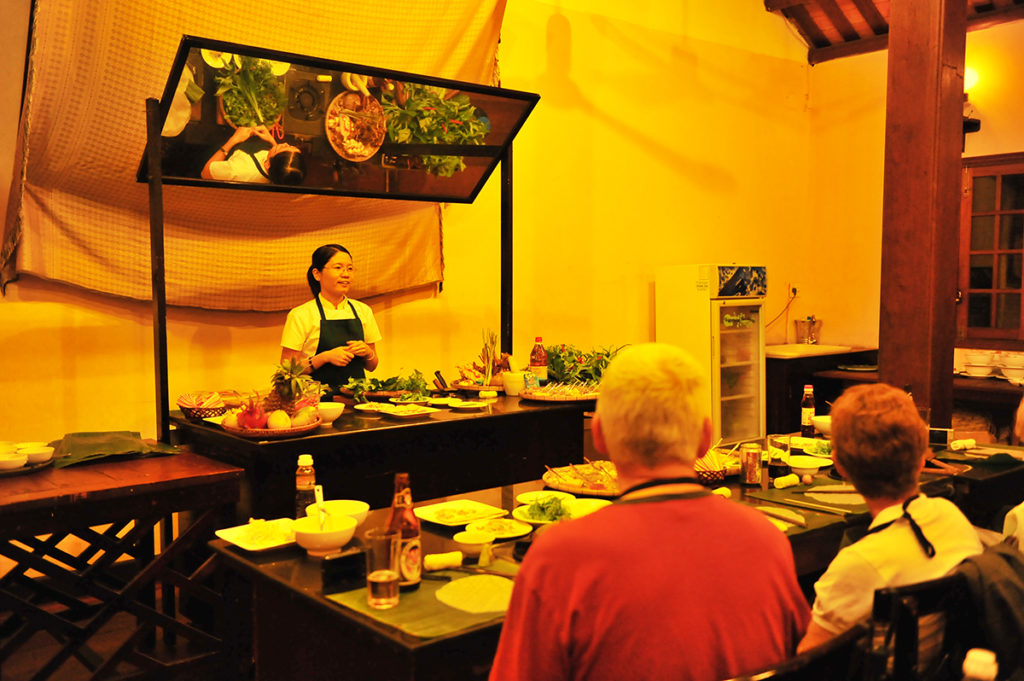
Here is a list of the top cooking class addresses in Hoi An that you can locate them using Google Maps.
- Hai Cafe Courtyard BBQ & Restaurant
- Red Bridge Restaurant & Cooking School
- Thuan Tinh Island Cooking Class
- Hoi An Eco Cooking Class
- Tra Que Herb Village
- Morning Glory Cooking School
- Secret Garden Hoi An
- Green Bamboo Cooking School & Café
Tips before you book a cooking class
Before your booking, ask the following questions:
- How many hours does a class take place?
- Do you like a full day, half-day, or just 1-2 hour cooking class?
- Would you rather want the class in a countryside place, a coffee shop, or a cooking school?
- What food do you want to learn to cook and eat? Ask for the menu of the class in advance by directly contacting the hosts, through emails, or a phone call. Knowing in advance what to cook and eat can benefit you a lot.
- Do you want the package to include a visit to the market, the vegetable village, or a boat trip?
The cooking class is the must-have experience in Hoi An Ancient Town that all foodies will be pleased with their tasty efforts. During class time, listen to the chefs’ live demonstrations on how to cook, then be confident to horn your cooking skill, your fusion, and gastronomy. Perhaps, it’s you that can surprise the teacher and other classmates at how beautiful and delicious your food is on completion. Being a cook in Hoi An is a cool idea to carry out once.
Introduction to Hoi An Ancient Town ‘s Food
Cao Lau – Braised pork noodles
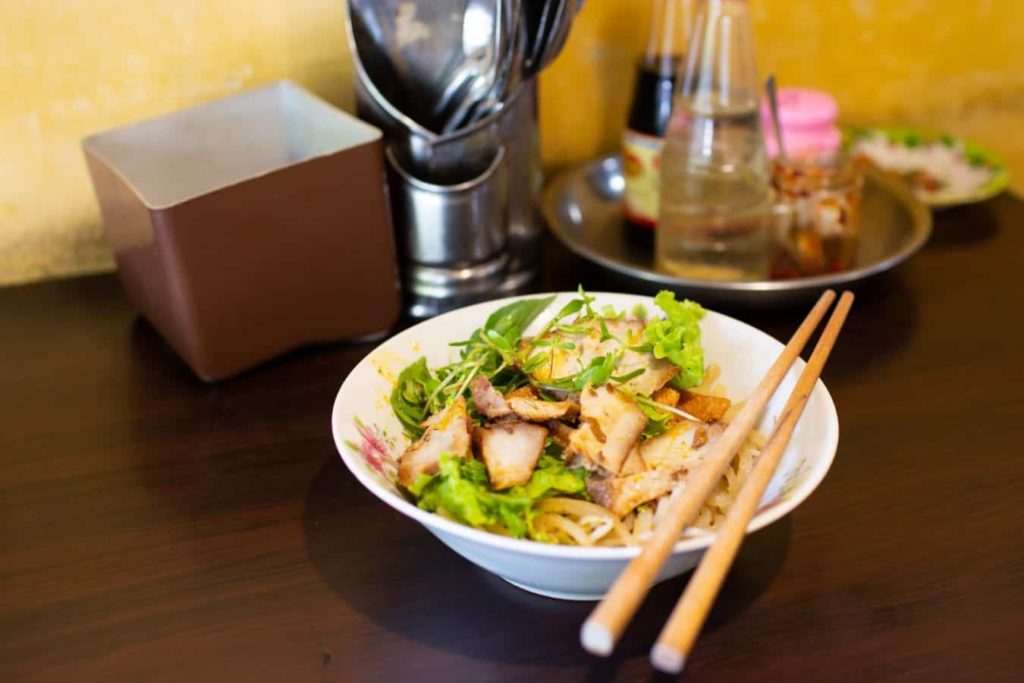
Cao Lau is a unique signature food in Hoi An Old Town. A bowl of Cao Lau should include yellow noodles, dark pork broth, pork slices, bean sprout, crouton, and Tra Que’s organic vegetables. A special trait is that the noodles are only mixed with the water from the local Ba Le Well, which links to the local history. Oftentimes, the food is served with a small amount of broth. You might find “Cao Lau” or the braised pork noodles nowhere but only in the Old Town. Therefore, make sure you taste it. People might ask for more croutons to eat with the soup.
Banh Vac – White Rose Dumplings
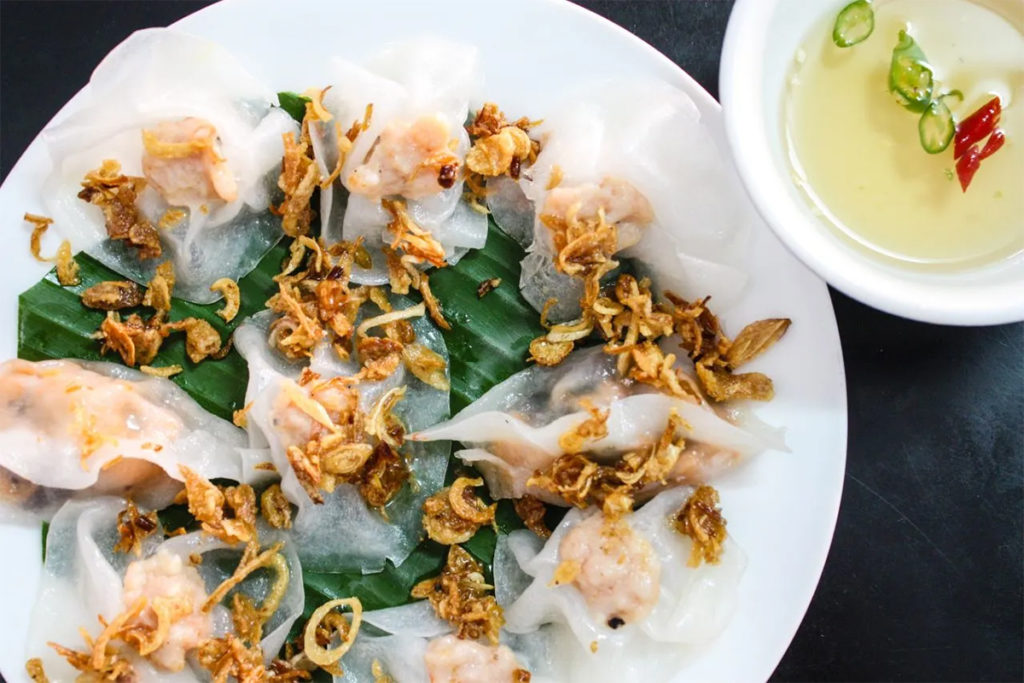
This is the best dumpling in the town and the must-eat. This is also the unique white rose cake in Vietnam, which can be only found in Hoi An. Dumplings or “Banh Bao, Banh Vac” are served together on a single plate. The main ingredient is rice starch. The rice must be new, aromatic, grind, and filtered many times by the water (taken from the local Ba Le well) for creating the white and smooth cake surface. The water needs to be filtered and purified 15-20 times before mixing with the rice for an airy dough. The dough will be rolled thin and cut into the dumpling-sized objects with the thin crust. About the fillings, they include fresh shrimp and ground pork mixed with mushroom, pepper, onion, salt, and fish sauce. That said, a secretive seasoning of the Hoi An people is also added, which makes it unique. Another secret might lie in the skill of the cooks who can shape the dumpling well. If the crust is too thick, the taste failed to please foodies and the filling might not be well cooked. After being steamed for 10-15 minutes, the cakes are ready to serve. Typically, around 15 “roses” on a plate would cost USD 4.
Com Ga Hoi An – Hoi An Chicken Rice
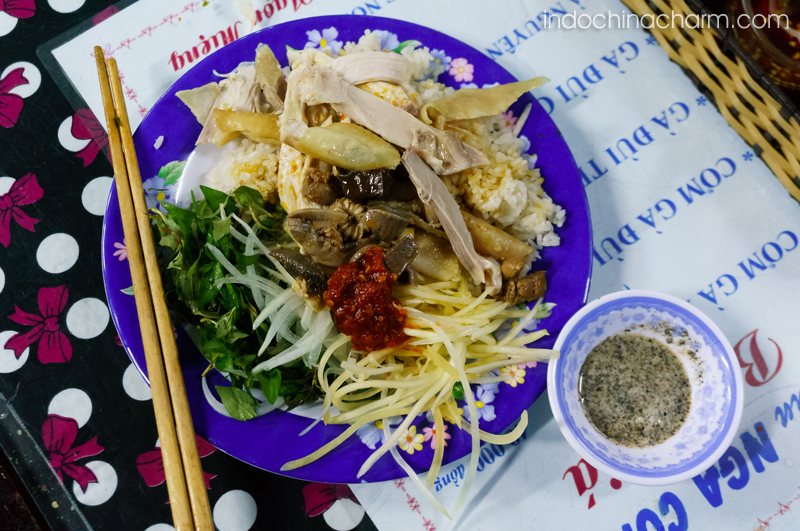
A typical plate of Hoi An Chicken Rice would include turmeric rice topped with shredded chicken, pickled green chilis, and vegetables. It’s also served with a small bowl of soup and dipping sauce. The fluffy rice and the Hoi An’s chicken bring different tastes that can convince foodies of its specialty and authenticity. Nowadays, due to the popularity of the food, it’s feasible to find “Com Ga Hoi An” throughout the big cities like Saigon and Da Nang, but the one in Hoi An brings the distinctive taste and look.
My Quang – Quang noodles
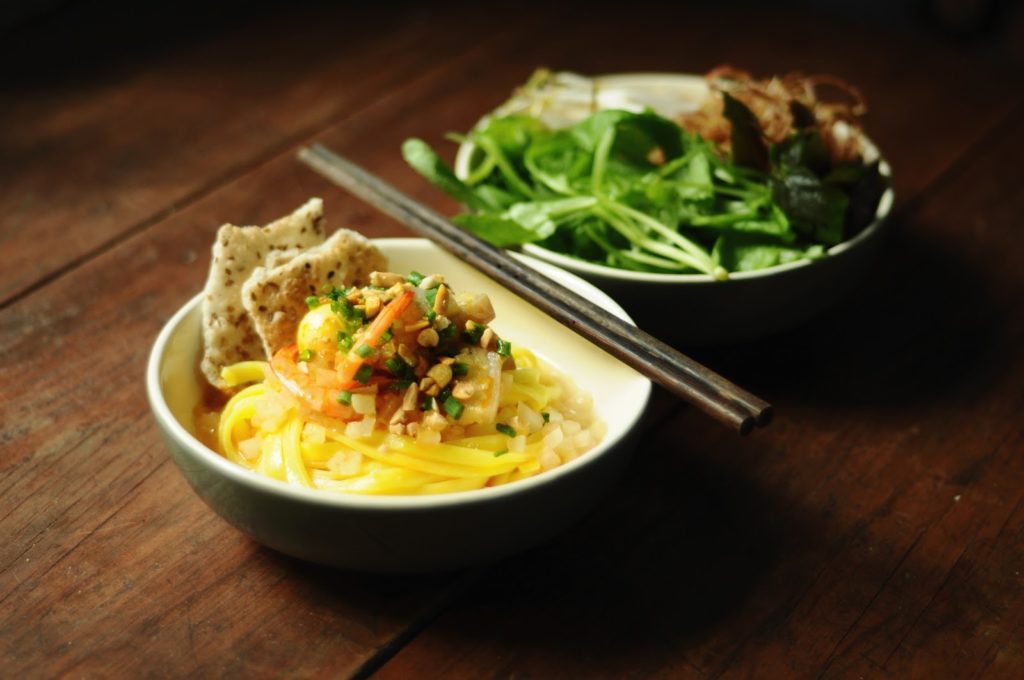
It’s easy to spot the eateries that serve Quang Noodles in some corners of the Old Town. A bowl of the yellow rice noodles also includes broth seasoned with black pepper, fish sauce, shallots, etc., and topped with shrimp, pork, local greens, and herbs. To enhance the taste, the food is complemented by sesame rice crackers. Just like the chicken rice in terms of popularity, this kind of turmeric noodles has been made popular in the big cities. Saigon does serve it, and people of Quang Nam can enjoy the food when they’re working far from home to feel nostalgic. Surely, Hoi An food owns the original taste, which is the best of all.
Bun Dau Mam Tom – Fried tofu and rice vermicelli
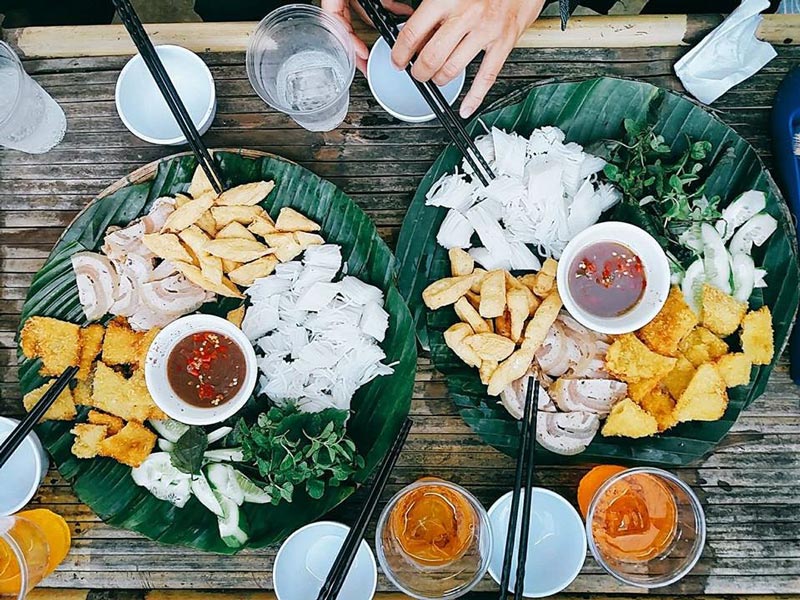
This Vietnamese food is about fried tofu and rice vermicelli served with fermented shrimp paste. All components will be served on a tray that wins people’s compliments on the fried tofu, steamed pork, fish balls, and other kinds of vegetables. And, the heart of the tray is a bowl of fermented shrimp paste, which is the irreplaceable dipping sauce. Some foodies might find the smell of this paste too strong, then they can ask to change the sauce. Besides, others might prefer a meatless variation, which can be served for vegetarians.
Banh Beo – Steamed rice cake
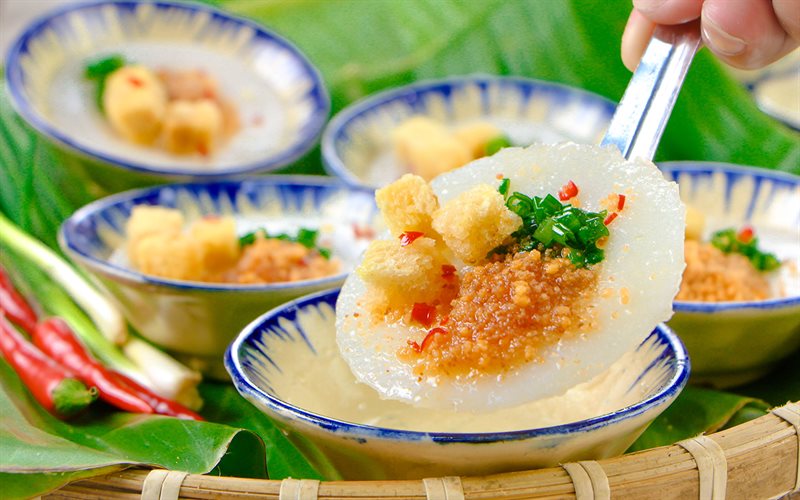
Banh Beo or steamed rice cake is made from white rice flour, and the complete set is topped with tomato sauce, shrimp, minced pork, and fried shallot. A plate of rice cakes cannot be perfect without the well-balanced fish sauce that soaks all components to enhance the flavor. As a traditional dish in Hoi An, Banh Beo owns an attractive white look dotted with other colors of the toppings. People love eating and photographing this food in Hoi An, and you can easily find eateries that serve this cake throughout the city corners.
Introduction to Hoi An Ancient Town ‘s Lantern Full Moon Festival

The festival takes place every full moon cycle. Both locals and visitors can join the festival filled with beautiful lanterns. The celebration is to honor the ancestors so people will exchange lanterns, candles, flowers, and fruits, with hope for wealth, health, and good luck. The whole town will be lightened up by the well-lit lanterns almost everywhere. The landscape in the full town is so special that makes people remember it for a long time. Hoi An in the full moon is differently miraculous as a large number of lanterns in the shops, houses, etc., and even on the river will illuminate the area. On the 14th – 15th of a lunar month, people will float the lanterns and garlands on the Hoai River, which carry the best wishes about the best things. Some families will turn off the lights and use the lanterns. Everything creates fantastic scenery. Both locals and tourists can float the lanterns and garlands. Before you float it, remember to think and pray. In the moonlight, people can also enjoy a boat trip on the Hoai River, which is amongst the best things to do in Hoi An Ancient Town. The Old City is twinkling as thousands of well-lit lanterns and garlands keep illuminating it. Sometimes, the cool wind might please your body and mind during the boat trip. Look above! The fully brightened moon is a perfect object for photography. Every corner your boat runs toward, the moon is full, sacred, and marvelous in the sky. Furthermore, the full moon reflecting on the river is precious.
The next thing to do is to take a walk at the city illuminated by no electric lights as people enjoy lighting their houses and shops by the candlelight of the lanterns. With the endless love for the symbolic lanterns, the locals are proud to replace the electric lights with the speaking items of tradition and creativity – the lanterns. Under the moonlight, people seem to value every second past, so they tend to speak in a low voice and walk in a slow pace as none and nothing wants to mess the peacefully sparkling townscape. The atmosphere is also ideal for the “millions of likes” photographs on your Facebook or Instagram. This is when numerous fantastic “so-deep” shots will be created within a night. Meanwhile, reward yourself with a beautiful culinary experience by trying Hoi An chicken rice, Quang noodle, pancake with eggs, steamed rice cakes, etc. Traveling to Hoi An on the full moon will turn out to be an unforgettable memory to anybody getting there on the right phase. When other places are noted for the skyscrapers that hide the moon, this Old Town is exclusive. The full moon might be the best time to visit Hoi An Vietnam for a journey of peace, tradition, and distinction.
Introduction to Hoi An Ancient Town ‘s Future Orientation
The master plan to conserve, restore, and promote Hoi An Ancient Town besides the tourism development has come into effect since 2012, covering the period until 2025. It targets to improve the local people’s living conditions who can earn by serving the tourists. In the coming time, there will be an attempt to connect Hoi An Old Town with the adjacent UNESCO Cu Lao Cham Biosphere Reserve, which establishes a community of ecology, culture, and tourism in the region. Hoi An Old Town is amongst the most ancient and most peaceful sites to visit in Vietnam. Whether you’re interested in the old architecture, the peaceful atmosphere, the colored lanterns, or the romantic boat trips, this is a lovely and praiseworthy venue where travelers all over the world gather. The town is devoted to the back-in-time traveling episodes.

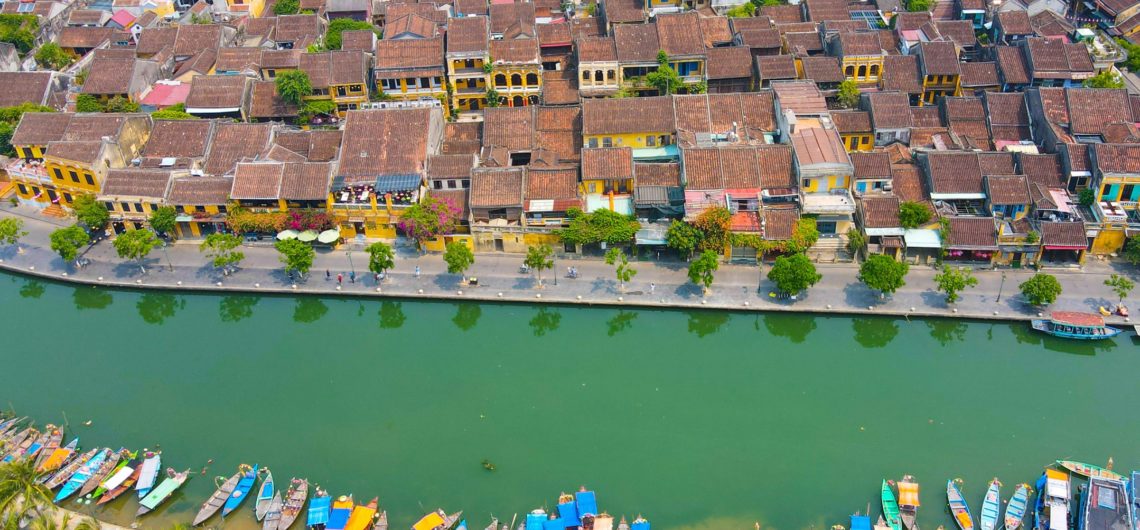
Comments